A significant number of requirements are now being put forward for automobile lamps, in particular regarding their performance indicators and characteristics. Indeed, from the very beginning of the use of batteries and lighting fixtures the market began to offer the most different models lamps
Socles car lamps and their markings
To produce correct selection lamps for your car, first of all you should take into account the characteristics of the car itself - the maximum permissible power of the lamps, the shape and size of the base for the lamp. Also, do not forget about the conditions of use of lighting devices, since this also affects visibility at night, as well as the color of the light beam.
Often, the simplicity of selecting optical elements is ensured by basic data about the car - make, model, production date, volume of the power plant. The type and type of car lamp is usually indicated on its bulb and base, as well as on the packaging. The most popular ones at the moment are ordinary incandescent and halogen lamps, and recently they have also appeared.
Some types of lamps are combined, using two spirals, which gives them the ability to perform two functions at once, for example, one lamp can work both as side lights and as a brake light. Lamp manufacturers usually indicate the main characteristics of their products, along with explanations, which makes it easy to select optical elements for a car based on its data.
Conventional incandescent lamps

The first to be installed on cars were incandescent lamps, which are now called classic. Edison's invention, which is what this lamp is, is a transparent spherical flask with a spiral of tungsten wire placed inside, and all the air has been pumped out of the flask. When electricity is supplied to the coil, it causes the wire to heat up, accompanied by light emission. However, such lamps have very low efficiency - only 6-8%. The temperature of the filament is 2000 degrees on the Kelvin scale, with its yellow tint is also now considered weak. This characteristic significantly falls short of natural sunlight, so such an incandescent lamp is not very suitable for perception by the human eye.
Moreover, this lamp is susceptible to high temperatures, and tungsten itself can settle in the form of small particles on inner surface transparent flask, which causes fogging. Due to their design features, incandescent lamps are not able to focus the light beam with reflectors.
Halogen lamps
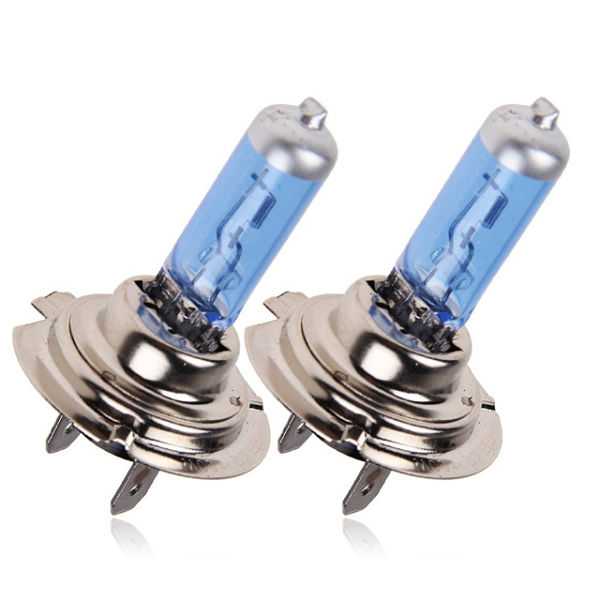
The appearance of halogen lamps on the market made it possible to solve many of the inconveniences that occurred when using conventional incandescent automobile lamps. These elements changed the shape of the flask, it took on cylindrical shape, which also affected the size of the tungsten spiral. Inside the flask there is no longer a vacuum, but an inert gas, including halogen vapor. This feature The design of halogen lamps has led to the emergence of a self-cleaning process, since tungsten particles do not settle on the bulb, but during operation they again settle on the spiral. Since the glass does not fog, the light beam capacity of these lamps is higher. In addition, the color temperature of halogen lamps is higher - 2700-3000 Kelvin, which provides better light perception by the eye.
Video: H4 lamp test
But there is also a drawback in this design - any touch to the bulb with your hand can lead to a disruption in the distribution of energy inside the bulb, which in turn leads to the appearance of cracks in the bulb and breakage of the lamp.
Xenon lamps

They are gas-discharge and are considered one of the latest developments in the field of automotive lighting. Externally, such lamps are very similar to halogen lamps, but their operating principle and design are different. The bulb of such a lamp is filled with xenon, and when electricity is supplied, an arc appears inside it between the electrodes, creating a light beam. These lamps have a very high color temperature. Moreover, different models are produced that provide their own shade of light. Thus, an 8000 K lamp provides a light beam with a blue tint, and for 5000-7000 K lamps this beam is close in shade to that of the sun. The lighting efficiency of xenon lamps significantly exceeds those described above, and they are quite reliable, since their design does not include a tungsten filament.
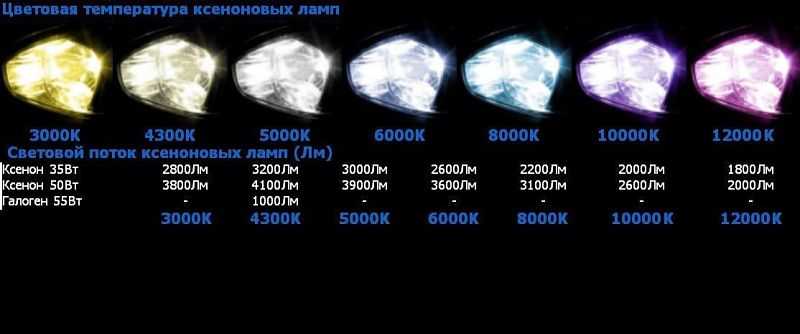
But these lamps also have disadvantages, and the first of them is the need to use additional equipment (ignition unit), which provides a voltage of 20 thousand volts to the lamp, necessary for the arc to appear. The second drawback is the same powerful beam of light - for the driver such a lamp will shine well, but for those driving towards him, such a light can greatly interfere and dazzle.
There are enough of this type of lamps complex design, therefore, it cannot be manufactured under artisanal conditions, which eliminates the possibility of purchasing counterfeit lighting elements on the market.
LED lighting elements

At first, these lamps were installed only in rear lighting devices - brake lights, tail lights, etc. The first LED lamps white began to be installed in 2004 on the A8 W12 model from Audi. In a very short time, LED technology, which is LED lamps, has become very popular and a complete transition to them in the production of cars is already quite possible.
To the advantages LED lamps applies:
- Vibration and shock resistance;
- Significant resource;
- Low power consumption;
- High light temperature;
- Environmental friendliness;
At the same time, changing any other lamp to an LED lamp is not accompanied by any modifications to the car; it is quite enough to find out what type of socket is used on the car and select a lamp according to the similarity table of lighting elements.
Marking of automobile lamps by base
The base in the lamp is needed not only to secure the lamp in the socket and ensure the tightness of the bulb, it also ensures the transfer of electrical energy to the lighting mechanism. As for LED lamps, they only need a base for fastening and transmitting electricity; they do not need sealing.
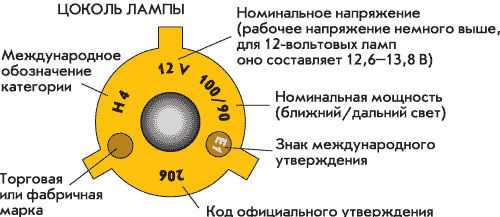
GOSTs are also applied to automobile lamps, in particular 2023-88, thanks to which all types of lamps can be divided into several categories.
As for the division by base, there are lamps:
- ordinary automobile (marking “A”);
- automotive miniature (AMN);
- Automotive soffit (AC);
- Halogen quartz (AKG);
- Miniature (T);
- With metal base (R);
- With a flask with a diameter of over 40 mm (R2);
- With a flask up to 26.5 mm and a base of 15 mm (P);
- Double-base soffit for license plate lighting (SV(C));
- Pin symmetrical (BA);
- Pin with one pin offset in height (BAY);
- Pin with one pin offset in height and radius (BAZ);
- Glass base (W);
Halogen lamps have an additional letter “H” in their markings. Also, if its marking contains the letter “Y” at the beginning, this means that its bulb is orange.
Lamps are also classified according to the number of connecting contacts, and this classification is also alphabetic.
Since the operation of lighting devices directly affects traffic safety, manufacturers are required to ensure that they comply with government and government regulations. international standards. In this case, we mean the “UN Economic Commission for Europe Regulations” No. 37, which are the basic European standard for the safety of road transport vehicles. Confirmation of compliance with the rules is called homologation. If a part or assembly is homologated, it bears the approval mark E in a circle and a number indicating the country code. Assemblies and parts that do not comply with this standard are prohibited for use in Europe. Approval country number of this device, placed in a circle next to the letter “E”. For example: 1 - Germany, 2 - France, 5 - Sweden, 22 - Russia.
The most important element of lighting devices, lamps, are the most standardized parts in the global automotive industry.
Unlike household electric lamps, automobile lamps operate under conditions of shaking and vibration and, accordingly, have more durable spirals (they use a different brand of tungsten). Socles with round inch thread very rare on lamps for mobile equipment. Here, spring-loaded sockets or clamps are used to prevent the lamp mount from being twisted or loosened.
This principle of fixing a lamp in a socket has become widely used in the automotive industry, undergoing only some modifications.
Flange lamps
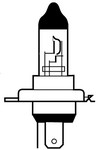 |
|||||
| R 2 | H 1 | H 3 | HR 2 | H 4 | H 7 |
Flange - have a strict tolerance on the location of the spiral relative to the flange, which means they allow it to be placed exactly at the focus of the reflector of the optical element or at the required distance from it. If the flange lamp is intended for a headlight or spotlight, then its spiral high beam either compactly curled, as if approaching an ideal point light source, or stretched along the optical axis of the reflector (lamp H1, H7). If the lamp is intended for fog lights, then the spiral can be perpendicular to the optical axis (lamp H3).
R2 lamps belong to the old generation of lighting devices and are used in two headlight lighting systems. Their use is limited to old cars and agricultural machinery.
Lamps H1 and H7 are used in four car headlight systems. Moreover, if earlier the H1 lamp was used for both low and high beam, then with the advent of the H7 lamp its use was limited in optics high beam or fog lights. This is due to the fact that the H7 lamp is designed for the latest generation optics and, along with high performance characteristics (low temperature base and less dazzling light) has 20% greater brightness compared to the H1 lamp. H4 category lamps are the most popular and in demand by car assembly plants. The ease of installation, adjustment and replacement is a definite advantage for economy class cars. However, the main drawback is the low luminous efficiency for the low beam filament only 1000 lm. For comparison, the luminous efficiency of the H7 lamp is 1500 Lm. Comments, as they say, are unnecessary.
Pin lamps
| T4W | H6WH21W | R5WR10W | P21W | PY 21 W |
Pin lamps are the most commonly used automotive lamps. If there can be from 2 to 6 flange lamps on a car, then there are from 10 to 20 pin lamps. Pins on cylindrical surface the plinths can be located either symmetrically or with one of them offset. The pin is shifted in height on two filament lamps (P21/5W) to ensure a certain position of the lamp in the socket. Pins offset around the circumference are usually used on lamps with orange glass bulbs (PY21W). Their appearance is due to the fact that on many modern cars, the direction indicator lenses have become colorless, due to design requirements. According to GOST, the direction indicators require an orange light, so the pins on the socket have been shifted, which makes it impossible to insert an ordinary incandescent lamp into the socket. Also found in the lighting programs of Western manufacturers are halogen lamps for indicator and parking lights (H6W, H21W) with offset pins. This eliminates their interchangeability with conventional lamps.
Spotlight lamps
Two-base (soffit) lamps are used in interior lampshades (their shape makes it possible to make the device quite flat, recessed into the upholstery panel), for license plate lights, as well as brake lights and turn signals of some cars.
Lamps with glass base
| T5 1.2 W | W5W | W16W | W21W |
Drivers call them baseless lamps. IN Lately they are replacing lamps with metal bases ranging from 1 W to 21 W. The role of the base is performed by a plastic socket, the contacts of which are pressed against the conductors removed from the lamp bulb. According to their dimensions, they come in four types. From dashboard lamps to brake and parking lamps. Their undoubted advantage is their high service life with small dimensions.
Lamps with a glass base welded to a plastic socket
 |
 |
Lamps with a plastic socket are used to illuminate control indicators and dashboard displays. To their design features can be attributed reliable fastening lamp contacts, socket and power plug, as well as missing surfaces that can rust and oxidize.
Gas discharge and halogen lamps with plastic sealing base
| H 8 | H 9 | H 11 | HB 3 HB 4 | HB 1 HB 5 | D 2 S D 2 R |
Modern headlight systems provide much brighter and more accurate illumination of the road surface. Based on H7 lamp technology, the latest powerful lamps H8, H9 and H11. They are the only lamps that can be used in particularly compact headlights.
HB3 and HB4 lamps, along with H8, H9 and H11 lamps, are used either separately or in conjunction with gas-discharge xenon-metal halide lamps. Combining lighting options provides the highest possible level and quality of light.
HB1 and HB5 lamps are used only on American cars. HB4 as head lamps for low beam, and HB3 for high beam. The use of the H8 lamp is limited to near-field optics and fog light, optimal choice for headlights, with requirements for low power consumption and special temperature conditions for heating the optical element. H9 lamps are used exclusively in high beams where a powerful luminous flux is needed. Use for low beam is only permitted with automatic headlight leveling. The H11 lamp has found application in all areas of development of optical elements. Ideally balanced in terms of design features, the lamp has the longest service life of up to 2000 hours.(jcomments on)
There are more than a hundred light bulbs in a modern car. The tasks vary, ranging from interior lighting, instrument panel lighting to ensuring visibility of the road at night. Depending on these purposes, lamps also have different dimensions, electrical characteristics, connecting base. It is about the base of car lamps that we will talk in this article.
Base - structural element lamp holding it in the socket, as well as an element transmitting current to power the lamp through its contacts (pads, petals, wire leads). The base also has another important task: sealing the lamp bulb from external environment. Many car lamps, especially high-power lamps (low and high beam, fog), are filled with gas. The base must provide a seal throughout the entire life of the lamp in order to prevent it from escaping from the bulb. In addition, in conventional incandescent lamps there is a vacuum, which is also hermetically sealed from the external environment by the base.
With the advent of LED lamps, such a function as sealing has become a rudiment, but not all lamps and not all cars have gotten rid of classical lamp incandescent
Types and designation of automobile lamps and sockets
At the dawn of the automotive industry, the designation of lamps and the use of sockets were chaotic; each manufacturer used what he thought was the best. As a result, the number of types of light bulbs tended to infinity. Today, the defining standard for lamp manufacturers in our country is GOST 2023-88. Of course, it is not perfect, since progress is not worth it, and GOST is from 1988; nevertheless, most automobile lamps and sockets are described in it.
Depending on the number of contacts at the lamp base, the corresponding letter is added
s - one contact
d - two contacts
t - three contacts
q - four contacts
p - five contacts
Types of car lamp bases
A – car lamp.
AMN – miniature automobile lamp.
AC – automotive spotlight lamp.
AKG is a quartz halogen automotive lamp.
T - miniature base lamp. The base is made together with the flask. Example designation for example (T5 4W) - 5/8 inch diameter lamp, 4 watts.
R – lamp with a 15 mm metal base and a 19 mm bulb. Designation for example (R 5W) – power 5 watts.
R2 - The diameter of the flask is about 40 mm. Incandescent lamps used in Soviet times for high and low beam. At the moment they are almost not used.
P - lamp with a 15 mm base and bulb diameter up to 26.5 mm. Example designation (P21W) – power 21 watts.
SV (C) – soffit lamp (base is located on both sides). As a rule, it is used for interior lighting and license plate lighting. Designation for example SV8.5 5w – the lamp has a base diameter of 8.5 mm, power 5 watts. May be designated as C5W.
VA is a pin-type lamp, in which each pin is located symmetrically relative to the others.
BAY is a pin lamp in which one of the pins is offset in height.
BAZ is a pin lamp with a pin offset in height and radius.
W – the lamp base is made together with a glass bulb. Example of designation (W 2 * 4.6d 5W) - the base is made together with a glass bulb, base thickness 2 mm, width 4.6 mm, 2 contacts, power 5 watts.
Designation of lamps not based on the base
The most common halogen lamps can have different bases, but start with the same letter H, which means halogen. There are also digital values, which also indicate the unique shape and base of the lamp, such as 9145 (fog lamp).
Designation of lamps by luminous light
Y – if the letter is after the first character, then this lamp is made with orange flasks. Example designation (PY21W) - lamp with 15 mm base, 26.5 mm bulb, with orange bulb.
The following is a drawing by which you can compare the description given above with the appearance of a car lamp and base
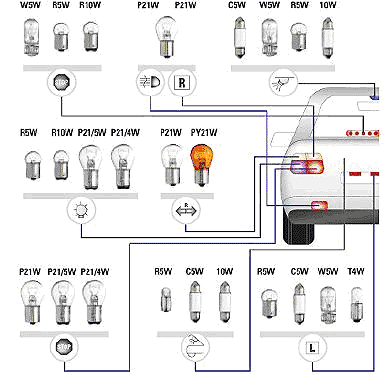
lamp H1 base P14.5s
lamp H2 base X511
lamp H3 socket PK22s
lamp H4 base P43t
lamp H7 base PX26d
lamp H11 base PGJ19-2
lamp H8 socket PGJ19-1
lamp H9 socket PGJ19-5
lamp H12 base PZ20d
lamp H10 base PY20d
lamp HB3 socket P20d
lamp HB4 base P22d
lamp D1S base PK32d-2
lamp D1R base PK32d-3
lamp D2S socket P32d-2
lamp D2R base P32d-3
lamp PY21W base BAU15s
lamp P21W base BA15s
lamp P21/4W socket BAZ15d
lamp P21/5W socket BAY15s
lamp R5W socket BA15s
lamp R10W socket BA15s
lamp T4W socket BA9s
lamp W5W base W2.1x9.5d
lamp W3W base W2.1x9.5d
lamp W2.3W base W2x4.6d
lamp WY2.3W base W2x4.6d
lamp WY5W base W2.1x9.5d
lamp H6W base BAX9s
lamp H21W base BAY9s
lamp C5W socket SV8.5-8
lamp HB1 base P29t
lamp HB5 base PX29t
lamp WP21W base WZ2.5x16d
lamp P27W base WZ2.5x16d
lamp C21W base SV8.5-8
lamp W21W base W3x16d
lamp W21/5W base W3x16q
lamp W16W base W2.1x9.5d
lamp WP21W base WY2.5x16d
lamp PY27/7w base WX2.5x16q
Lamps used in cars - incandescent, halogen and gas-discharge lamps for cars. Types, markings, characteristics, operating features
At the moment, many varieties of lamps have appeared, with different requirements for them and performance characteristics. At the dawn of the automobile industry, even wax candles but everything changed with the advent of a current source (battery) and the invention of the first light bulb (Edison’s invention)
Incandescent lamps

The classic incandescent light bulb looks spherical glass bowl from silicate glass(bulb), there is a tungsten filament inside the lamp, while there is a vacuum in the lamp cavity. The principle of operation is that when passing electric current electrons heat up the tungsten coil and electromagnetic thermal radiation occurs with a glow effect. The average efficiency of such lamps is about 6-8%, in particular, the efficiency depends on the wavelength of the emitted light, and it depends on the temperature of the filament, which is limited in conventional lamps. The average temperature of an incandescent lamp filament is 2000 K; at a higher filament temperature, it simply burns out. That is, the manufacturing technology and materials do not allow obtaining the desired high temperature, thereby providing a spectrum close to the spectrum of the sun. In addition, the disadvantage of these lamps is the fogging of the bulb due to the settling of tungsten released from the surface of the lamp filament at high temperatures, thereby limiting the permeability of the glass. The significant length of the lamp filament makes it difficult to focus the light beam with the headlight reflector, which limits visibility on the road. Some types of incandescent lamps were produced with a double spiral.
These lamps are marked with the index R2.
Ordinary classic light bulbs, although they were quite popular, were, unfortunately, completely impractical. It seems that at the moment the place for automobile incandescent lamps is only in a museum. Nowadays you can no longer find ordinary incandescent light bulbs for sale in a car dealership, which have been replaced by halogen lamps.
Halogen lamps
Halogen lamps solved some of the problems associated with conventional light bulbs. Starting even from the shape due to which the length of the filament became shorter, and the bulb of the lamp was cylindrical made of quartz glass. Besides, in halogen lamps ah instead of vacuum filled inert gas with halogen vapors (iodine, bromine and others). The use of such a filler in flasks made it possible to carry out a physicochemical reaction of returning tungsten molecules back to the filament of a halogen lamp. Thus, the glass of halogen lamps seems to self-clean, thereby constantly transmitting a greater number of photons of light through the surface of the bulb. Halogen lamps made it possible to maintain a higher filament temperature, which changed the wavelength of the emitted spectrum and increased the efficiency of the lamps. The temperature of the filament of halogen lamps is 2700-3000 K. So why can’t you pick up a halogen light bulb with your hands, all because of the same high operating temperatures of this lamp. When we touch glass, we always leave fingerprints, and with them grease, dirt, and so on, which in turn affects the uneven distribution of temperature throughout the quartz bulb of a halogen lamp. In case of violation temperature regime The bulb may crack, causing the halogen bulb to naturally fail. This requirement By maintaining the cleanliness of the surface of the bulb, the lamps can also be classified as gas-discharge lamps, but more on them later. Currently, halogen lamps are the most common for use in cars.
Automotive gas discharge lamps, xenon
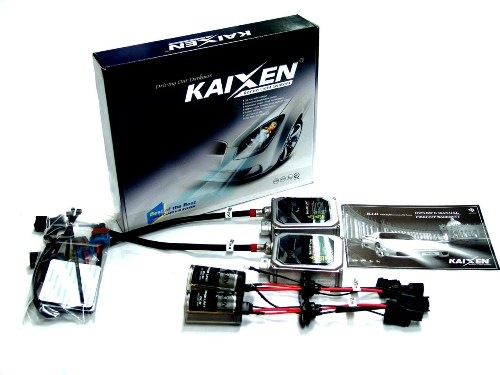
Gas discharge lamps were the latest to appear in the mid-90s. They look like halogen light bulbs, but the principle of their operation is completely different. The flask is filled with gas (most often xenon as it is inexpensive and ensures operation). In xenon, an electric arc is created between the electrodes, thereby emitting light. The temperature of gas-discharge (xenon) lamps is the highest, so much so that, as you have noticed if you have ever seen the glow of xenon, the emitted spectrum, due to the high temperature and lower wave frequency, has a blue tint. As a result, the efficiency of gas-discharge lamps is several times higher than that of halogen and conventional lamps.
Gas-discharge (xenon) lamps also have advantages due to the fact that it is impossible to shake the filament, which provides xenon lamps with longevity and reliability.
The disadvantages of gas-discharge xenon lamps are optional equipment, the boosting multiplier of which supplies the lamps with a voltage of up to 20,000 volts necessary to create an electric arc. And how strange it is that plus and minus are too much high level emitted light, which has a negative impact on safety traffic. If gas-discharge (xenon) lamps are installed on a car, then this work must be carried out in the factory. More about xenon headlights can be read in the section of our website ( Xenon light, xenon lamps in the car)
LED BULBS

Using LEDs in car headlights started in 1992, when red LEDs were used to equip additional upper brake lights and rear lights. The first automaker to use white LEDs as lamps for headlights was Audi in the A8 W12 in 2004. Development of LED LED technologies allows us to now carry out a full replacement of traditional lighting devices. The rate of progress of LEDs in recent years is commendable. LED parameters double every year. Judging by the current trend, a kilowatt LED may be available in 5 years!
At the moment, LED lamps make it possible to replace standard light bulbs in car lamps and headlights. LED lamps for cars have standard plinth, so no modifications are required to install them.
LED lamps for cars are superior to traditional incandescent and halogen lamps in many respects. Main advantages LED headlights:
- Shock and vibration resistance;
- Long term services;
- Low power consumption;
- High brightness;
- Environmental Safety.
If you want to change the lamps in your headlights to LED ones, first determine what type of auto lamps are installed on your car using the catalog of interchangeability of conventional lamps with LED lamps.

Side light of headlights. A special feature of the front headlight lamps is their ability to withstand high temperatures up to 100 degrees, since they are located next to the headlights. This causes heating, the LED crystals cannot withstand it and fail. To protect the LED from overheating, some lamp models are equipped with a current stabilizer, which prevents an increase in the current passing through the crystal as the temperature rises. Such models of LED lamps are the most reliable and are recommended for use as front markers.
The latest SMD series LED lamps use surface mount diodes. They are compact, have a fairly wide radiation pattern and high brightness. All model data in the designation code have SMD marking. The distribution of light in them is provided by sets of LEDs, each of which consists of four microchips, with free-form reflectors. Three more sets of two microchips, providing illumination at the border of light and shadow and within the range of headlights, are hidden behind the lens. These are joined by the driving lights, which consist of one set of four microchips in each of two reflector housings.
Now on sale you can find some of the following models of LED light bulbs for cars: FKXLDL010007 LED headlights daylight, round, with relay, 4 high-efficiency LEDs, 12/24 V;
FKXLDL010009 LED daytime running lights, with relay, 28 LEDs, 12 V; FKXLDL003 Side lights, daytime running lights, 5 high performance LEDs; FKBLR2001 Side lights, daytime running lights, 8 high performance LEDs;
FKXLDL010011 LED daytime running lights, with relay, 6 high performance LEDs, 12 V.
Prices for LED headlights are still significantly higher than traditional ones, but considering that the service life of such a headlight is 10 times longer, buying it seems like a reasonable option. Moreover, recently many online stores have been selling various LED headlights.
Marking of lamps used in cars.
Automotive headlight lamps (high and low)
- H1, H2, H3, H4, H7
H1 are used for cars with separate headlights for high and low beam. BMW, VAZ2106
H2 are designed for additional optics
H3 with an additional output in the form of a wire are used for fog lights.
H4 uses head optics and has a double filament filament
H7 is the latest type of lamp for cars manufactured after 1995, for free-form headlights.
Automotive lamps
HB - 1, 2, 3, 4 indicate their certification to American standards. As a result, they are usually installed on American and Japanese cars.
Automotive lamps D1 and D2 - gas-discharge lamps are marked with this index.
Most car component manufacturers are constantly improving their products and releasing their own brands - all-season (Philips - Allweather), all-weather (Osram - All Season), durable (Philips and Osram - Long Life), with 30% increased light output ( Philips - Premium, Osram - Super) and emitting light with a blue tint (Philips - Blue Vision, Osram - Cool Blue, Trifa - Xenon Blue). Additional information about the applicability and marking of lamps can be found in the section of our website (Lamps used in the VAZ 2110 2111 2112 car)
Selection of automotive lamps for use in the car
In order to avoid problems with the lamps and the car due to the lamps, the following requirements must be observed:
Polycarbonate headlights must be equipped with lamps with an ultraviolet spectrum filter. This spectrum has an excessive effect on the aging of polycarbonate headlights and the clouding of their glass.
It is best to choose a lamp based on the markings on the old lamp, and sometimes this marking printed on the glass of the headlight, such an example is shown in Figure 4 (the inscription halogen means that a halogen bulb is recommended for use in this headlight);
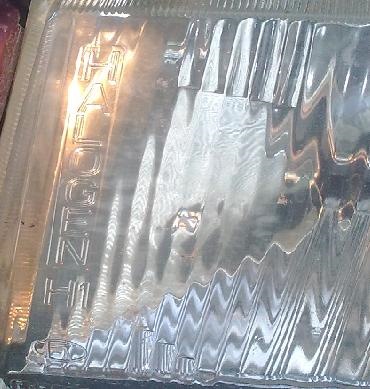
It is forbidden to touch your fingers glass flask lamps - residues of grease and dirt on the bulb will cause uneven heating, and its subsequent cracking;
Buying lamps in sets is usually cheaper than buying lamps individually
Do not install more powerful lamps than recommended due to possible overheating of the headlight glass and the appearance of cracks, as well as overheating of connecting blocks and wires;
Inscriptions on original lamps are usually applied with special equipment, but on fakes they can be erased with a stamp and paint, respectively, with a fingernail;
Car lamp sockets, types, designation
Car lamp bases There are more than a hundred light bulbs in a modern car. The tasks vary, ranging from interior lighting, instrument panel lighting to ensuring visibility of the road at night. Depending on these purposes, lamps also have different dimensions, electrical characteristics, and connecting base. It is about the base of car lamps that we will talk in this article.
The base is a structural element of the lamp that holds it in the socket, as well as an element that transmits current to power the lamp through its contacts (pads, petals, wire leads). The base also has another important task: sealing the lamp bulb from the external environment. Many car lamps, especially high-power lamps (low and high beam, fog), are filled with gas. The base must provide a seal throughout the entire life of the lamp in order to prevent it from escaping from the bulb. In addition, in conventional incandescent lamps there is a vacuum, which is also hermetically sealed from the external environment by the base.
With the advent of LED lamps, such a function as sealing has become a rudiment, but not all lamps and not all cars have gotten rid of the classic incandescent lamp.
Types and designation of automobile lamps and sockets
At the dawn of the automotive industry, the designation of lamps and the use of sockets were chaotic; each manufacturer used what he thought was the best. As a result, the number of types of light bulbs tended to infinity. Today, the defining standard for lamp manufacturers in our country is GOST 2023-88. Of course, it is not perfect, since progress is not worth it, and GOST is from 1988; nevertheless, most automobile lamps and sockets are described in it.
Depending on the number of contacts at the lamp base, the corresponding letter is added
s - one contact
d - two contacts
t - three contacts
q - four contacts
p - five contacts
Types of car lamp bases
A – car lamp.
AMN – miniature automobile lamp.
AC – automotive spotlight lamp.
AKG is a quartz halogen automotive lamp.
T - miniature base lamp. The base is made together with the flask. Example designation for example (T5 4W) - 5/8 inch diameter lamp, 4 watts.
R – lamp with a 15 mm metal base and a 19 mm bulb. Designation for example (R 5W) – power 5 watts.
R2 - The diameter of the flask is about 40 mm. Incandescent lamps used in Soviet times for high and low beam. At the moment they are almost not used.
P - lamp with a 15 mm base and bulb diameter up to 26.5 mm. Example designation (P21W) – power 21 watts.
SV (C) – soffit lamp (base is located on both sides). As a rule, it is used for interior lighting and license plate lighting. Designation for example SV8.5 5w – the lamp has a base diameter of 8.5 mm, power 5 watts. May be designated as C5W.
VA is a pin-type lamp, in which each pin is located symmetrically relative to the others.
BAY is a pin lamp in which one of the pins is offset in height.
BAZ is a pin lamp with a pin offset in height and radius.
W – the lamp base is made together with a glass bulb. Example of designation (W 2 * 4.6d 5W) - the base is made together with a glass bulb, base thickness 2 mm, width 4.6 mm, 2 contacts, power 5 watts.
Designation of lamps not based on the base
The most common halogen lamps can have different bases, but start with the same letter H, which means halogen. There are also numerical values that also indicate the unique shape and base of the lamp, for example 9145 (fog lamp).
Designation of lamps by luminous light
Y – if the letter is after the first character, then this lamp is made with an orange bulb color. Example designation (PY21W) - lamp with 15 mm base, 26.5 mm bulb, with orange bulb.
The following is a drawing by which you can compare the description given above with the appearance of a car lamp and base
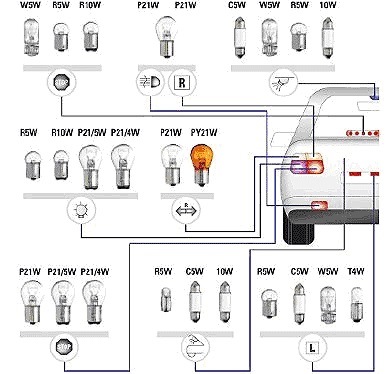
2 years
The current GOST 8769–75 provides for the presence of eight types of external lighting devices on vehicles. Each of them differs in design and purpose, which forces manufacturers to install Various types automobile lamps.
To help vehicle owners navigate among the variety of shapes and sizes of car lamps, let’s consider their main types, fundamental differences and replacement options. The reference material provided will be useful to everyone who is directly or indirectly involved in vehicle maintenance.
Marking
Despite the agreement among automakers on unification, the classification of automobile lamps includes dozens of lighting devices that differ in the shape of the bulb and the type of base. The following letters are used in the designation of Soviet-style automobile lamps:
- A – automobile;
- C – soffit;
- MN - miniature;
- KG – quartz halogen.
The full light bulb abbreviation also includes the voltage rating, wattage, and design number that follow the letter code. Unfortunately, such an abbreviation is not informative, and car bulbs marked according to GOST 2023-88 are in demand exclusively in old domestic cars.
Another relevant and more universal marking today is made according to a single European standard. It includes the following basic letters:
- H – halogen;
- D – xenon;
- T – miniature low power with one base;
- R – base diameter – 15 mm, flask diameter – 19 mm;
- P – base diameter – 15 mm, flask diameter – no more than 26.5 mm;
- W – without metal base;
- Y is an additional symbol indicating the yellow color of the bulb.
At the end symbol add a lowercase letter indicating the number of electrical contacts:
- s (single) – 1;
- d (duo) – 2;
- t(tres) – 3;
- q (quatro) – 4;
- p(penta) – 5.

Variety according to the type of car lamps
Depending on the source of light, all types of automobile light bulbs are divided into three groups, each of which has its own gradation.
Halogen
Halogen lamps are a light source with an incandescent filament inside a bulb filled with halogen gas. Despite many shortcomings, they continue to occupy a leadership position due to their low price and the reluctance of many car enthusiasts to switch to xenon and LEDs. Sooner or later, the improvement of LED car lamps will replace halogen lamps with their short service life and low light output with relatively high energy consumption. Initially, the symbol “H” indicated a halogen lamp, and the number indicated the standard size. The xenon and LED bulbs that appeared later continued to be produced in standard housings. As a result, products with different sources lights can be made in the same housing, for example, H7.
But this does not mean they are completely interchangeable. In a halogen lamp, the distance from the flange to the spiral is a fixed value, on which the geometry of the light beam depends. A slight deviation of the spiral from the center greatly affects the focal length and, as a result, the clarity of the light spot. IN gas discharge lamp the light source is an arc, and in LED - one or more LEDs. They are all different color temperature and the angle of light propagation, which means they require individual selection of optics.
Gas discharge
A xenon auto lamp has a quartz glass flask into which a mixture of gases is pumped. Thanks to the accurate chemical composition, during lamp operation, a beam of light with a given color temperature is formed. A ceramic insert and a steel flange serve as a barrier between the red-hot bulb and the base parts. All elements of the base are made using thermal insulation material and seals that ensure additional protection. Its operation is impossible without an ignition unit, which sets the exact value of the supply voltage.
Xenon-based gas-discharge lamps can be divided into three large groups:
- Xenon lamps with pinout type H1-H27, HB3-HB5, designed for retrofitting standard vehicle lights.
- Bi-xenon lamps manufactured according to the H4M, HB1M, H13M standard and others with the “M” index. Their purpose is to replace halogen lamps, which are both a source of low and high beam.
- Xenon lamps with D1S, D1R – D4S, D4R standard sockets installed on the vehicle by the manufacturer.
LED
LED car lamps are a relatively new representative on the car market, the light source of which is one or more LEDs. Due to the constant improvement of technology, appearance LED car lamps are also changing. Remains unchanged basement part, which exactly repeats the dimensions of the bases of halogen light bulbs. LED lighting fixtures must work in tandem with a driver that provides voltage and current stabilization. The bulk of LED products for cars are produced on SMD chips, but gradually the initiative is moving to COB matrices.
If low-current LEDs have fully met expectations in organizing interior lighting, license plates and dimensions, then high-power LED auto lamps still remain the weak link among the entire volume of lighting devices. The high cost of branded LED headlight bulbs is beyond the means of the average driver, and cheap Chinese products have already gained a bad reputation. The main reasons are the discrepancy between the stated characteristics of reality and the low quality of the product.
Base variety
During operation, car light bulbs are subject to strong vibration. In this regard, all structural elements have increased strength, and the mounting socket for the base is equipped with a clamp or spring contacts. All types of car lamp bases are absolutely different from their household counterparts. Therefore, in addition to indicating the type of car lamp, markings on the base are required.
With protective flange
The presence of a flange is indicated by the symbol “P”, with which the base code begins (H4-P43t). Powerful lamps for headlights are available with a flange. For example, popular models installed in low-beam, high-beam and PTF headlights with H3, H4, H7, HB3, HB4 sockets. This also includes less popular ones - H1, H12, R2 and many others.
Soffit
This type of base is designated “SV”. The auto lamp has a cylindrical shape, 30-40 mm long, with two bases at the edges. This design allows you to save inner space and minimize the size of the lampshade. They have found the greatest application in interior lighting, where lamps are built into the upholstery. Spot light sources are also used to illuminate registration plates and brake lights (for example, C5W-SV8.5-8).
Pin
These lamps have a smooth cylindrical base with two symmetrically “BA” or asymmetrically “BAY” “BAZ” pins for rigid fixation. The offset of the pins is necessary in order to exclude the possibility of installing a different type of light bulb, for example, white instead of yellow. The inscription: “PY21W-BAY15s” means that this lamp has a yellow bulb, a pin-type base with a diameter of 15 mm with one contact, a power of 21 W.
With glass base
The coding for all glass lighting fixtures begins with the letter “W” followed by the size of the base in millimeters (W21W-W3x16d). They are very practical and are in demand in many car lights: turn indicators, dimensions, dashboard etc.
New types of socles
Plug-in connections of the new format are developed, as a rule, for LED lamps. Their appearance is explained by an attempt to promote LED products, and is also a kind of protection for the driver from the installation of other types of lighting devices.
We hope this article will help with the choice of car lamps and simplify the task of purchasing through online stores, where it is necessary to indicate the exact labeling of the product. When purchasing a light bulb from a local store, it is advisable to take the burned out bulb with you to ensure they are identical not only with the code, but also visually.
Read also




